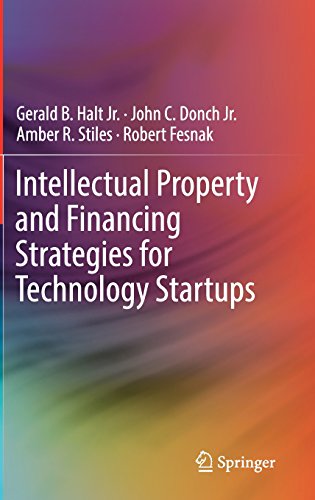Intellectual Property and Financing Strategies for Technology Startups 1st Edition by Gerald Halt, John Donch, Amber Stiles, Robert Fesnak 3319492179 9783319492179
$50.00 Original price was: $50.00.$25.00Current price is: $25.00.
Intellectual Property and Financing Strategies for Technology Startups 1st Edition by Gerald B. Halt, John C. Donch, Amber R. Stiles, Robert Fesnak – Ebook PDF Instant Download/Delivery: 3319492179, 9783319492179
Full download Intellectual Property and Financing Strategies for Technology Startups 1st Edition after payment

Product details:
ISBN 10: 3319492179
ISBN 13: 9783319492179
Author: Gerald B. Halt, John C. Donch, Amber R. Stiles, Robert Fesnak
This book offers a comprehensive, easy to understand guide for startup entities and developing companies, providing insight on the various sources of funding that are available, how these funding sources are useful at each stage of a company’s development, and offers a comprehensive intellectual property strategy that parallels each stage of development. The IP strategies offered in this book take into consideration the goals that most startups and companies have at each stage of development, as well as the limitations that exist at each stage (i.e., limited available resources earmarked for intellectual property asset development), and provides solutions that startups and companies can implement to maximize their return on intellectual property investments. This book also includes a number of descriptive examples, case studies and scenarios to illustrate the topics discussed, and is intended for use by startups and companies across all industries. Readers will garner an appreciation for the value that intellectual property rights provide to a startup entity or company and will gain an understanding of the types of intellectual property rights that are available to companies and how to procure, utilize and monetize those intellectual property rights to help their company grow.
Intellectual Property and Financing Strategies for Technology Startups 1st table of contents:
1 Introduction
Startup Funding Sources, Stages of the Life Cycle of a Business, and the Corresponding Intellectual
2 Sources of Company Funding
Abstract
2.1 Seed Capital and Early-Stage Funding
2.1.1 Personal Investment/Bootstrapping
2.1.2 Friends and Family Funding
2.1.3 Private or Governmental Grant Funding Options
2.1.3.1 Federal/State/Regional/Local Government Grants
Small Business Grants
Small Business Innovation Research Grants
Small Business Technology Transfer Grants
Private and Foundation Grants
2.1.4 Crowdfunding
2.1.4.1 Case Study: Kickstarter
2.1.4.2 Case Study: Crowdfunder
2.2 Equity Funding
2.2.1 Angel Investors
2.2.2 Venture Capital
2.2.3 Rounds of Venture Capital Financing—Series A, Series B, Series C, etc.
2.2.4 Business Incubators and Accelerators as a Source of Equity Financing
2.3 Debt Funding
2.3.1 Loans
2.3.1.1 Small Business Loans
2.3.1.2 Peer-to-Peer Loans
2.3.2 Lines of Credit
2.3.2.1 Use of Credit Cards
2.3.2.2 Asset-Based Lines of Credit
2.3.3 Securitization with Intellectual Property
2.3.3.1 Case Study: Debt Financing with Bowie Bonds
2.3.4 Collateralization of IP
2.3.4.1 Case Study: Levi Strauss Borrows Against Trademarks and Other Assets
2.3.4.2 Case Study: Ford Leverages Trademarks and Patents for Loan
2.4 Mezzanine Financing
2.4.1 Subordinate Notes
2.4.2 Preferred Stock
2.5 Anticipated Rate of Return for Investors
3 Early-Stage Strategy
Abstract
3.1 IP Strategies at the Early Stage
3.2 Consult with an Intellectual Property Attorney
3.3 Begin Building an IP Portfolio and an IP Strategy
3.3.1 Trademarks
3.3.1.1 Securing Trademark Protection for Company Names, Logos, and Product Names, Logos, and Design
3.3.1.2 Obtaining a Domain Name
3.3.2 Copyrights
3.3.2.1 Web site Copyrights
3.3.2.2 Valuable Works of Authorship
3.3.3 Opting for the Trade Secret Route
3.3.4 Patents
3.3.4.1 Taking Advantage of Microentity or Small Entity Status
3.3.4.2 Filing a Provisional Patent Application
3.4 Early-Stage Companies Seeking Investors Need a Business Plan
3.4.1 Integrating an Intellectual Property Strategy into a Business Plan
3.4.2 IP Due Diligence
3.4.3 IP Portfolio Development Plan
3.5 Joining a Business Incubator or Accelerator
3.5.1 Case Study: Techstars
3.5.2 Industry-Specific Startup Service Providers and Specialty Incubators
3.5.2.1 Case Study: Healthcare Technology Incubator Rock Health
3.5.2.2 Case Study: Culinary Incubator La Cocina
3.5.2.3 Case Study: Incubator Partnerships with Universities
3.6 Summary
4 Growth and Expansion Stage
Abstract
4.1 Benefits of Leveraging IP During the Growth and Expansion Stage
4.2 Leveraging IP: Strategies for Obtaining Debt or Equity Funding
4.3 IP Strategies at the Growth and Expansion Stage—Enhancing Your IP Portfolio
4.3.1 Filing a Non-provisional Patent Application
4.3.1.1 Converting a Provisional Patent Application into a Non-provisional Patent Application
4.3.1.2 Filing a Non-provisional Patent Application that Claims the Benefit of a Provisional Patent
4.3.1.3 Filing a Non-provisional Patent Application
4.3.2 Enhancing Your Portfolio with Trademarks
4.3.3 Enhancing Your Portfolio with Copyrights
4.3.4 Other Intangible Assets that Can Have Value for a Company
4.3.4.1 Identifying Potentially Valuable Intangible Assets
4.3.4.2 Entering into Agreements to Extract Value from Intangible Assets
4.3.4.3 Intangible Assets that Make a Company Investment-Worthy
4.3.5 Utilizing Trade Secret Protection
4.4 Using IP Rights as Leverage in Business
4.5 Partnership Funding/Strategic Investments
4.6 Licensing Intellectual Property
4.6.1 What Is An Intellectual Property License?
4.6.2 Factors to Consider in an IP License
4.6.2.1 Identification of Rights to Be Licensed
4.6.3 License Restrictions
4.6.4 Consideration
4.6.5 Maintenance of IP Rights
4.6.6 Other Terms
4.7 Cross-Licensing
4.8 Focus on Marketing, Partnerships, and IP
4.8.1 Marketing the Company
4.9 Summary
5 Mature, Exit, and Rebirth Stages
Abstract
5.1 Reaching the Mature Stage with Your Company
5.2 Consider Expanding Patent Protection
5.2.1 Expedited Patent Examination Options
5.2.2 Continuation and Divisional Patent Applications
5.2.3 International Patent Filings
5.3 Consider Making Strategic Partnerships
5.4 Exit Strategies
5.4.1 Being Bought Out
5.4.1.1 Positioning a Company to Be an Attractive Acquisition Target
5.4.2 Divestiture of IP
5.4.2.1 Selling IP
5.4.2.2 Auctioning IP
5.5 Rebirth of a Company
5.5.1 Spinning off IP into a New Company
5.5.2 Cross-Industry Applications: Channel Programs
5.6 Summary
6 Achieving Success Stage
Abstract
6.1 Defining Success
6.2 Signing a Major Customer
6.3 Initial Public Offering
6.4 Acquisition of a Competitor
6.5 Suggested Timeline
Overview of Intellectual Property Rights for Startups
7 Trademarks and Trade Dress
Abstract
7.1 Trademarking a Startup’s Company Name, Logo, and Domain Name
7.2 What Is a Trademark?
7.3 Choosing and Developing a Brand for Your Startup
7.4 Non-protectable Subject Matter
7.5 Selecting a Trademark
7.5.1 Brainstorming Phase
7.5.2 Narrowing Phase
7.5.3 Knockout Phase
7.5.4 Clearance Search
7.5.5 Obtaining a Legal Opinion
7.6 Protecting a Trademark
7.6.1 Common Law of Trademark
7.6.2 Federal Trademark Protection
7.6.3 State Registration
7.6.4 International Protection
7.7 Maintaining Trademark Rights
7.7.1 Maintaining Federal Registration
7.7.2 Licensing Trademarks
7.7.3 Assignment of Trademarks
7.7.4 Policing Trademark Use
7.7.4.1 Genericide
8 Domain Names
Abstract
8.1 Securing Intellectual Property in Domain Names
8.2 Domain Name Disputes
8.3 Case Study: Domain Dispute Between Startup Codecademy and Code Academy
8.4 New Top-Level Domains
8.5 New Top-Level Domains and Startups
9 Patents
Abstract
9.1 Patent Protection as an Intellectual Property Strategy for Startups
9.2 Patentability Requirements in the USA
9.2.1 Patentable Subject Matter
9.2.2 Invention Has Utility
9.2.3 Invention Is Novel
9.2.4 Invention Is Non-obvious
9.3 Types of Patents
9.4 Provisional Applications
9.5 Non-provisional Applications
9.5.1 The Anatomy of a Patent Application
9.5.1.1 Claims
9.5.1.2 Specification
9.5.2 Assignment of Patent Rights
9.5.3 Inventorship Versus Ownership
9.5.4 What to Expect: The Patent Application Examination Process
9.5.5 Continuing Applications
9.6 Going Global: International Patent Considerations
9.7 Patent Protection for Software
10 Trade Secrets
Abstract
10.1 Secrecy Creates Value: How Startups Utilize Trade Secret Protection
10.2 What Laws Protect Trade Secrets?
10.2.1 The Uniform Trade Secrets Act
10.2.2 The Defend Trade Secrets Act
10.3 Independent Discovery and Reverse Engineering of Trade Secrets
10.4 Theft of Trade Secrets: Misappropriation
10.4.1 Corporate Espionage
10.4.2 Employee Poaching
10.4.3 Cybertheft
11 Copyrights
Abstract
11.1 Copyrightable Subject Matter
11.2 Scope of Protection
11.2.1 Software and Apps as Copyrightable Matter
11.2.2 Advertising, Marketing Materials, and Product Packaging
11.2.3 Training Manuals, User Manuals, and the Like
11.2.4 Secret and Other Materials Including Software
11.3 Ownership and Authorship
11.3.1 Works for Hire
11.3.2 Jointly Authored Works
11.4 Licensing and Assignment of Copyrights
11.5 Derivative Works
11.6 Fair Use
11.7 Registration Issues
12 Intellectual Property Issues in Labeling and Marketing
Abstract
12.1 Government Controls Over Advertisements and Labeling
12.1.1 Federal Trade Commission
12.1.2 State Regulation
12.1.3 Government Controls Abroad
12.1.4 Patent Marking
12.2 Non-government Controls
12.3 Comparative Advertising
13 Enforcement and Infringement of Intellectual Property Rights
Abstract
13.1 Policing Your IP Rights
13.2 Evaluating a Controversy Before Commencing Litigation
13.3 Remedies
13.3.1 Injunctions
13.3.2 Payment of Royalties
13.3.3 Monetary Damages
13.4 Settling Controversy Without Litigation
13.4.1 Arbitration
13.4.2 Mediation
13.4.3 Licensing Agreements
13.5 IP Litigation
13.5.1 Selecting a Jurisdiction
13.5.2 Causes of Action
13.5.3 Preliminary Injunction
13.5.4 Discovery Stage
13.5.5 Summary Judgment
13.5.6 Trial
13.5.7 Costs
13.6 Proceedings in the United States Patent and Trademark Office
13.6.1 Trademark Oppositions
13.6.2 Patent Post-grant Review Proceedings
Implementation of IP Strategies for Startups
14 Successful Implementation of a Startup’s IP Strategy
Abstract
14.1 Talk with an Intellectual Property Lawyer
14.2 Confidential Disclosure or Non-disclosure Agreements
14.3 Assignment of Rights
14.4 Employee Education
14.5 Accurate Record Keeping
14.5.1 Patents
14.5.2 Trade Secrets
14.6 Patent and Trademark Searches
14.6.1 Patent Searches
14.6.2 Trademark Searches
14.7 Choosing the Best IP Protection for Your Startup
14.7.1 Deciding Between Patent or Trade Secret Protection
14.7.1.1 Differences in Scope of Protection
14.7.1.2 Differences in Litigation Remedies
14.7.1.3 Right Creation and Term of Protection
15 Developing and Managing an Intellectual Property Portfolio
Abstract
15.1 Developing an Intellectual Property Portfolio Strategy that Fits the Startup’s Business Goals
15.1.1 Identifying Startup Business Objectives and Goals and aligning these with the Startup’s IP
15.1.2 Identification of IP Assets
15.1.3 Periodic Review of IP Assets
15.2 Administrative Issues for Long-Term IP Portfolio Management
15.3 Ongoing IP Diligence: Protecting Rights and Pursuing Others
15.3.1 Defending Your IP
15.3.2 Leveraging Your IP Rights
16 Valuing Startup Companies
Abstract
16.1 Purpose of a Valuation
16.2 Methodologies
16.2.1 Cost or Asset-Based Approach
16.2.2 Income Approach
16.2.3 Market Approach
16.3 Normalization of Earnings and Cash Flows
16.4 Impact of Risk on Value and Cost of Capital
16.5 The Uniqueness of Early-Stage Technology Company Valuations
16.6 Allocation of Enterprise Value to Senior and Junior Equity Interests
16.6.1 The Current Value Method
16.6.2 The Option Pricing Method
16.6.3 The Probability-Weighted Expected Return Method
16.7 Leverage and Monetization of IP
16.7.1 Value of IP and Impact on Technology Companies
16.7.2 IP and the Enforcement of Rights
16.7.3 IP Monetization
17 Licensing of Intellectual Property Rights for Startups
Abstract
17.1 What Is an Intellectual Property License?
17.2 Factors to Consider in an IP License
17.2.1 Identification of Rights to Be Licensed
17.2.2 Restrictions
17.2.3 Considerations
17.2.4 Maintenance of IP Rights
17.2.5 Other Terms
17.3 Cross-Licensing Intellectual Property
17.4 Licensing Standard-Essential Patents
17.5 Licensing Code and Software
17.5.1 When a Startup Needs Software
17.5.2 When Startup Sells or Develops Software
18 Startup Tips for Avoiding and Preventing Intellectual Property Problems
Abstract
18.1 Get Legal Advice Early
18.2 Conduct Cost-Benefit Analysis on IP Protections
18.3 Do Things Correctly at the Outset
18.3.1 Protecting the IP You Have
18.3.1.1 Registering IP
18.3.1.2 Applying for Patent Protection
18.3.1.3 Use Contracts with Clear Clauses that Protect Your IP
18.3.2 Evaluate What IP Procurement Offers the Most Value
18.4 Take IP Protection, Policing, and Enforcement Seriously
18.4.1 IP Is Important, so Is Running Your Startup
18.5 Do not Infringe Others’ IP Rights
18.6 Prevent Contamination of IP Rights
People also search for Intellectual Property and Financing Strategies for Technology Startups 1st:
intellectual property financing
intellectual property loans
intellectual property strategy
using intellectual property as collateral
the intellectual property of a firm comprises
Tags: Intellectual Property, Financing Strategies, Technology Startups, Gerald Halt, John Donch, Amber Stiles, Robert Fesnak
You may also like…
Jurisprudence & Law - Intellectual Property
Intellectual Property Law: P. Narayanan Parameswaran Narayanan
Jurisprudence & Law - Legal Theory & Philosophy
Australian Intellectual Property Law 4th Edition Mark J. Davison
Business & Economics
Intellectual Property and Financing Strategies for Technology Startups 1st Edition Gerald B. Halt
Business & Economics
Jurisprudence & Law - Intellectual Property
The Intellectual Property Review 8th Edition by Dominick A Conde ISBN 9781838620257 1838620257
Jurisprudence & Law
Intellectual property : valuation, exploitation, and infringement damages Fifth Edition Parr
Business & Economics
Business & Economics
The Global Regime For The Enforcement Of Intellectual Property Rights Xavier Seuba 9781108231510
Business & Economics - Management & Leadership
Patent Management: Protecting Intellectual Property and Innovation 1st Edition Oliver Gassmann












